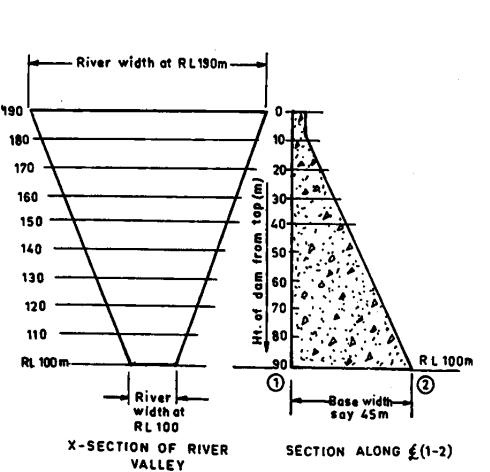Chapter: Civil : Water Resources and Irrigation Engineering : Diversion and Impounding Structures
Constant Radius Arch Dams and Angle Arch Dams
Constant Radius Arch Dams
A constant radius arch dam is that, in which, the radii of the outside water side or upstream side curved surface are equal at all elevations, from top to the bottom. The centres of all such circular arcs, called electrodes, will therefore, evidently lie on one vertical line. However, the intrudes (i,e inside downstream curved surface of the arch) has gradually decreasing radius from top to the bottom, so as to provide increased concrete thickness towards the base for accounting the proportionally increasing hydrostatic water pressure of the reservoir. The dam body will, therefore, be triangular in cross-section with upstream face vertical, and a minimum thickness at the top.
Evidently, it is only the radii of the introdos, which decrease with depth; while the centres of all such circular arcs continue to lie on the same vertical line, on which lie on the same vertical line, on which lie the centres of the extrodos. Hence, in such a dam, the centres of extrodos, introdos, as well as the centerlines of the horizontal arch rings, at various elevations, lie on a straight vertical line that passes through the centre of the horizontal arch ring at the crest. Such a dam, is therefore, sometimes called a constant centre arch dam, although strictly speaking, this centre is not at one point, but lies at different heights along one vertical line.
Evidently, the central angles of the arch rings of the introdos will vary at different elevations, due to the varying width of the river valley (see figure); the maximum being at the top of the dam, and the minimum at the bottom of the dam.
It has further been shown that the best or most economical central angle in an arch dam is the one whose value is equal to 133 o -34’ isthisderived in article a little later. But in a constant radius arch dam, such an angle value can be adopted only at one place, since the angle varies with height considerably, due to narrow V-shape of the valley. It is therefore considered prudent to


Figure: Constant radius arch dam.
Elevations, being maximum at the top, and a certain minimum at its bottom. This makes the central angles as large as possible, so that the maximum arch efficiency may be obtained at all elevations.
In a typical design of such a dam, the downstream face of the dam at the central line (crown) is vertical; while at all other locations, there is a batter on both the sides except at the abutments, where again, the upstream side becomes vertical. If overhands are permitted, due to availability of stronger foundations, then the faces at the crown as well as abutments, may be provided with overhangs, affecting saving in the designed thickness.
Evidently, since in such an arch dams, the centre of the various arch rings at different elevations, do not lie on the same vertical line; it is also known as variable centre arch dam. Such dams are preferred for V-shaped valleys as compared to constant radius arch dams which may be preferred for comparatively wider U-shaped valleys.
Constant Angle Arch Dams
The constant angle arch dam is a special type of variable radius arch dam, in which the central angles of the horizontal arch rings are of the same magnitude at al elevations, as shown in figure. The design of such a dam can, thus, be made by adopting the best central angle of 133Â o -
34’; and hence such a dam proves to be thearch mos dams, as pointed out earlier also.
However, the design of such a dam usually involves providing overhangs at abutments, which require stronger foundations, and hence such a type cannot be used if the foundations are weak.
Related Topics